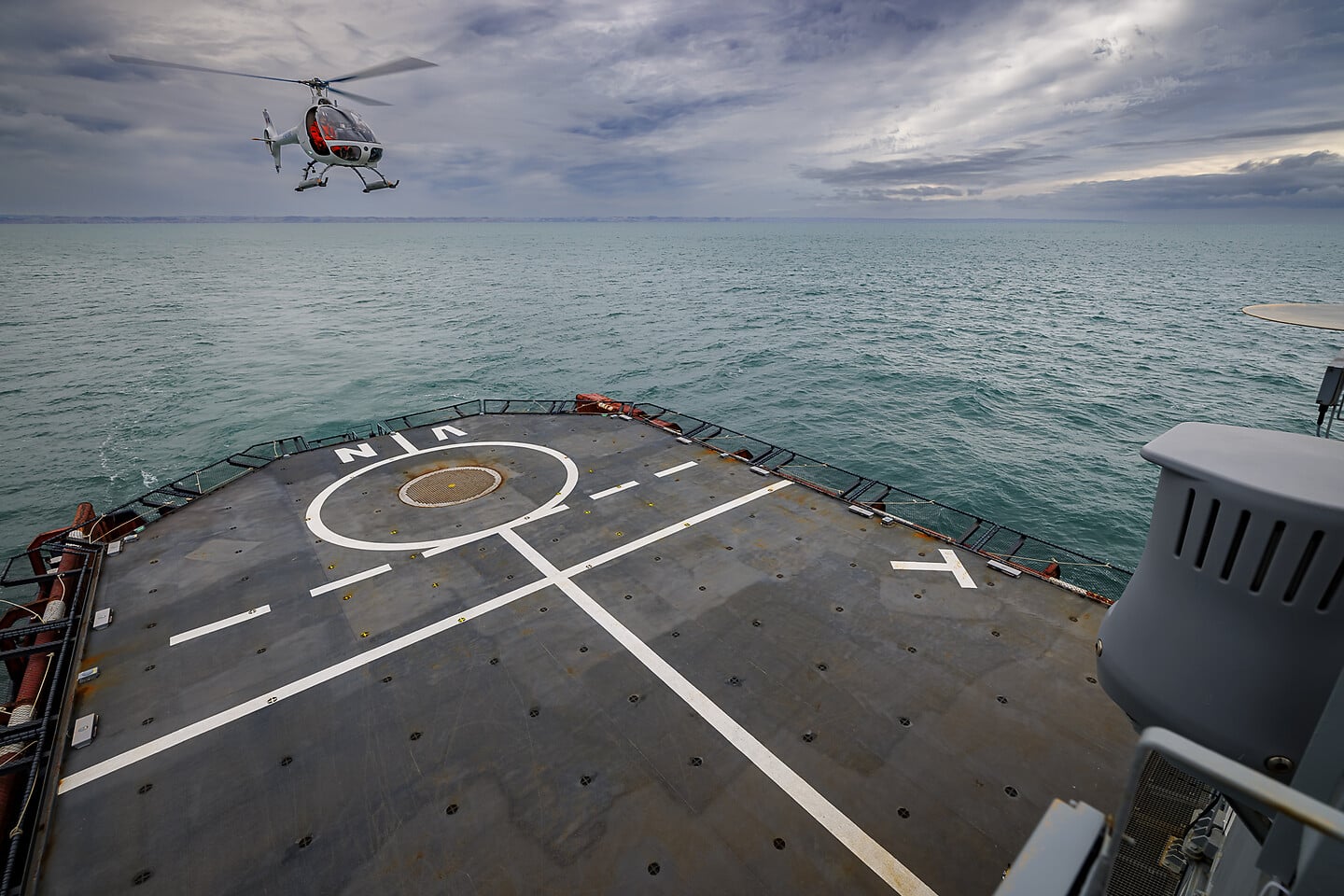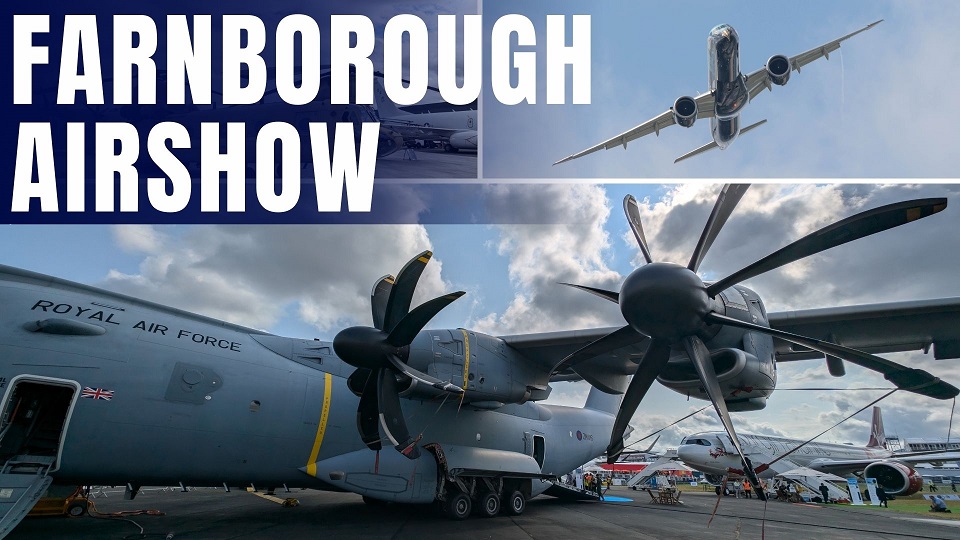Aviation
VSR700 autonomous take-off and landing capabilities tested at sea

Airbus Helicopters has began sea trials for the VSR700, an unmanned aerial system (UAS) being built for the French Navy as part of the SDAM (Système de drone aérien de la Marine) programme, which is being run by the DGA (Direction générale de l’Armement – the French Armament General Directorate). The trials were carried out with an optionally piloted vehicle (OPV) based on a modified Guimbal Cabri G2 that was fitted with the VSR700’s autonomous take-off and landing (ATOL) technology. This flight test campaign prepares the VSR700 for its impending sea display onboard a French Navy frigate.
The test was carried out in the presence of DGA specialists off the coast of Brest, France, onboard a civilian vessel with a helicopter landing deck. The experiments were meant to examine the approach procedures before landing on the vessel, in addition to showing the ATOL technology built for the VSR700. The VSR700 flight envelope was evaluated at sea, in close proximity to a vessel, in accordance with development goals, and found to be entirely compatible with naval operations. The ATOL system‘s semi-autonomous and completely autonomous modes were successfully tested in various sea conditions.
Before those features are integrated into the fully autonomous VSR700, the OPV may carry one test pilot to enable safer and more rapid first testing. Initially, the OPV performed manned take-offs and landings before progressing to completely autonomous movements.
What makes Dassaults Rafale fighter jet so special?
The VSR700 is a 500-1,000 kg maximum take-off weight UAS designed to work with other shipborne naval weapons. It has the finest payload capabilities, endurance, and operational cost balance. It can carry numerous full-size naval sensors for lengthy periods of time and can operate alongside a helicopter from current ships with a small logistical footprint.
Airbus concludes ATTOL with fully autonomous flight tests
The VSR700’s initial prototype flew for the first time in 2020 and enlarged its flying envelope in 2021. The DGA ordered a second prototype of the VSR700 in April 2021, focusing on trials addressing SDAM criteria and allowing for broader, faster progress toward that aim.
HOW MUCH FUEL SHOULD AN AIRCRAFT CARRY FOR THE TRIP? Explained
#VSR700 @AirbusHeli @MarineNationale @DGA

Aviation
Farnborough 2024: A Landmark Airshow Concludes with £81.5 Billion in Deals

As the 45th edition of the Farnborough International Airshow (FIA2024) concluded, it proved to be a tremendous success. The event, which ended yesterday, saw £81.5 billion worth of deals signed and 260 firm commercial aircraft orders placed within the first four days. For the UK alone, the deals announced amounted to £13 billion.
The show ended with an exhilarating final air display. The Starlings Aerobatic Team performed an impressive formation flight, while the Stampe Formation team showcased their vibrant heritage aircraft. The Royal Air Force’s F-35 flyover and the F-15QA’s powerful farewell flight added to the excitement. The British Army’s renowned Red Devils parachuted down, providing a spectacular closing to the event.
Day 2 Highlights: Airbus, Boeing, and Embraer Orders at Farnborough International Airshow 2024 : Click here
With this year’s orders finalized, the focus on the fifth and final day of FIA2024 shifted to inspiring the next generation of pilots, engineers, manufacturers, and innovators. We eagerly anticipate seeing everyone again at the Farnborough International Airshow 2026.
Airbus Expands Reach with Major Orders
Airbus has secured two significant deals that will expand its presence in the global market. The Abra Group, aiming to enhance its international long-haul operations, signed a Memorandum of Understanding (MoU) for five A350-900 aircraft. Additionally, flynas, Saudi Arabia’s leading low-cost carrier, strengthened its partnership with Airbus by signing an MoU for 75 A320neo family aircraft and 15 A330-900s.
Embaer Aircraft
In the military aviation sector, Embraer announced a major order from the Paraguayan Air Force (FAP) for six A-29 Super Tucano aircraft. This versatile, multi-mission aircraft will enhance the FAP’s capabilities in armed reconnaissance, close air support, light attack, and advanced training missions.
Virgin Atlantic also made headlines by ordering seven additional A330neo aircraft. This order highlights the airline’s confidence in the A330neo’s performance and passenger comfort, as well as its commitment to sustainability. The advanced technology and fuel efficiency of the A330neo make it an ideal choice for Virgin Atlantic’s transatlantic operations, aligning with their goal of providing an enhanced and eco-friendly travel experience.
Boeing aircraft.
Boeing also had a notable presence on Day 2 of the airshow. Qatar Airways announced an order for 20 additional 777-9 airplanes, reinforcing its commitment to the 777X program. The 777-9, touted as the world’s largest and most fuel-efficient twin-engine jet, is set to play a crucial role in Qatar Airways‘ long-haul fleet expansion, offering increased passenger capacity and improved fuel efficiency.
In a significant move for the leasing sector, Macquarie AirFinance announced its first direct order with Boeing, purchasing 20 737-8 aircraft. This order not only doubles Macquarie AirFinance’s existing 737-8 order book, acquired from ALAFCO Aviation Lease and Finance Co. in 2023, but also underscores the continued strong demand for the 737 MAX family, known for its efficiency and versatility.
-

 Travel1 week ago
Travel1 week agoAir India to Expand US Operations with Three New Routes After a Decade
-

 Travel2 weeks ago
Travel2 weeks agoWhy We Should Avoid These Stamps in a Passport
-

 Airlines1 month ago
Airlines1 month agoInvestigations Reveal Fake Chinese Titanium in Boeing and Airbus Jets
-

 Tech4 weeks ago
Tech4 weeks agoChina’s CATL Plans 1,800-Mile Electric Plane Launch by 2027
-

 Airport3 days ago
Airport3 days agoTop 10 Largest Airports in the World by Size
-

 Aerospace4 weeks ago
Aerospace4 weeks agoChina’s Fighter Jets Turn Wings into Autonomous Drones
-

 Airlines4 days ago
Airlines4 days agoAir India Rolls Out A350s for Delhi-New York JFK and Newark Routes
-

 Defence3 weeks ago
Defence3 weeks agoBoeing Enhances Chinook with New Engines and Block II Upgrades at $96 Million







